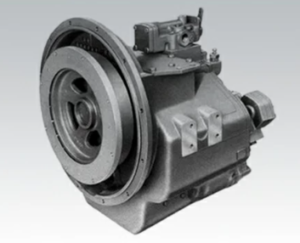

Parts Catalog for Twin Disc MG5091 Marine Transmissions
Rebuilt Twin Disc MG5091 Marine Transmissions
Plate Kit For Twin Disc MG5091 Marine Transmission
Gasket Kits For Twin Disc MG5091 Marine Transmission
The Twin Disc MG-5091 Marine Gear is engineered to deliver dependable propulsion power in the most demanding marine environments—from 24/7 commercial fishing operations to workboats, tugboats, and offshore support vessels. While the transmission is built to handle high loads, torque demands, and extended operational hours, the key to ensuring long service life and preventing unexpected failures lies in following a proactive and disciplined maintenance schedule.
This guide outlines a complete maintenance protocol broken into daily, weekly, monthly, and quarterly tasks to help vessel owners, marine technicians, and engine room crews extend the life of the MG-5091 and maintain peak operational performance.
When executed consistently, these service routines reduce wear, detect early warning signs of failure, and ensure your transmission is ready for any voyage or mission.
Daily Checks for Twin Disc MG-5091 Marine Gear
Daily checks serve as the first line of defense in transmission maintenance. Before each trip or shift, a brief but structured inspection can prevent issues like overheating, oil starvation, or pressure loss.
These checks should be performed by the engineer on duty, the vessel captain, or any assigned technician familiar with marine transmission operations.
1. Oil Level Inspection
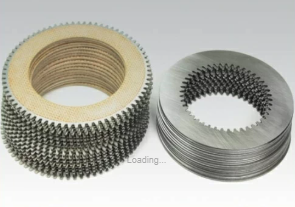
Why it matters: The MG-5091 depends entirely on oil to operate its hydraulic clutches, cool internal components, and reduce friction between moving parts. Operating with low oil can result in:
- Burned clutch plates
- Reduced gear pressure
- Internal scoring and bearing wear
- Immediate operational failure
How to perform the check:
- Ensure the engine is shut off and has had at least 5–10 minutes to cool.
- Locate the transmission dipstick (usually mounted at the top or side of the gearbox).
- Remove and clean the dipstick with a lint-free cloth.
- Reinsert fully and withdraw to get an accurate reading.
- Oil should fall between the “FULL” and “ADD” marks.
- Top off with the approved SAE 30 or SAE 40 oil, as specified by your operating environment.
Tip: Use a logbook to track any fluid consumption day over day. Rapid drops may indicate internal leakage or external weeping from seals.
2. Visual Inspections
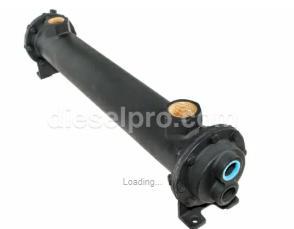
Purpose: Identify signs of trouble before they escalate into downtime or damage. Visual inspections are simple but effective.
Check the following daily:
- Transmission housing: Look for new oil stains, cracks, or corrosion.
- Oil cooler lines: Inspect for leaks, bulges, or loose fittings.
- Breather vents: Make sure they are clean and not clogged.
- Shift linkage or control cables: Ensure smooth operation with no signs of binding or corrosion.
- Mounting bolts: Look for signs of shifting, loosening, or flange movement.
Use a flashlight and inspection mirror to reach hard-to-see areas at the rear of the transmission or under its mounting pads.
3. Cold Start Monitoring
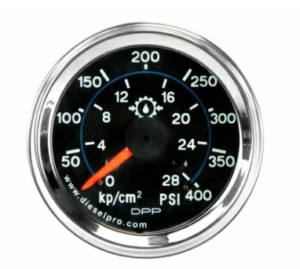
During the first five minutes of daily operation:
- Watch the oil pressure gauge to ensure it rises to expected levels (120–250 psi).
- Monitor oil temperature for early signs of overheating.
- Listen for unusual noises like whining, grinding, or delayed clutch engagement.
If abnormalities appear, stop the engine and troubleshoot immediately. A noisy startup could indicate aerated oil, clutch drag, or suction blockage.
Weekly Tasks for Twin Disc MG-5091 Marine Gear
Weekly maintenance tasks are designed to go beyond surface-level inspection and address components subject to progressive wear, vibration, and misalignment. For vessels in continuous operation, these checks can be integrated into a weekly engine room checklist.
1. Leak Checks
Leaks may begin as harmless seepage but quickly evolve into major failures. The MG-5091 includes multiple points where leaks commonly develop:
Check the following:
- Input shaft seal (engine side): Look for oil around the bellhousing junction.
- Output shaft seal: Examine the propeller coupling area for oil accumulation.
- Cooler connections: Inspect for weeping at hose clamps or fittings.
- Drain plugs: Ensure plug torque and thread sealant are intact.
Types of leaks:
| Leak Type | Common Cause | Action Required |
| Drip (1-2/day) | Heat expansion, loose fitting | Monitor and retorque as needed |
| Weep (surface) | Seal aging or shaft misalignment | Schedule seal replacement |
| Pooled fluid | Shaft seal failure or internal crack | Shut down and investigate immediately |
Tip: Place an absorbent pad under the gearbox to track leak size and source over time.
2. Coupling Checks
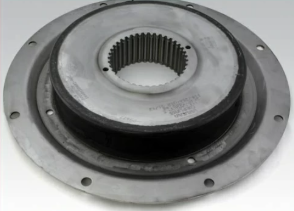
Proper alignment and secure coupling between the gearbox and the propeller shaft is critical. Even minor misalignment or bolt loosening can cause:
- Vibration
- Shaft wear
- Seal degradation
- Flange cracking
Weekly Coupling Inspection Protocol:
- Use a torque wrench to verify that output flange bolts are at the specified torque (typically 125–135 ft-lbs for 5/8″ bolts).
- Visually inspect for:
- Paint chipping (indicates movement)
- Polishing marks on flange faces (indicates fretting)
- Bolt elongation or slotting
- Check for alignment shifts using a dial indicator or feeler gauges.
- Listen for new noises during shaft rotation—a ticking sound may mean misalignment or coupling wear.
If shaft alignment deviates beyond 0.003” total runout, realignment should be scheduled before the next operation.
3. Filter and Breather Cleaning
Each week:
- Inspect the oil breather cap and clean off dirt or sludge that may restrict airflow.
- Wipe down external oil filter housings to check for drips.
- If equipped with a magnetic drain plug, remove and inspect for metal shavings.
Excessive ferrous debris indicates wear on clutch hubs or planetary gears. Document and escalate if abnormal.
Monthly/Quarterly Tasks for Twin Disc MG-5091 Marine Gear
Monthly and quarterly tasks are part of a longer-term condition monitoring program. These steps help identify emerging mechanical issues before they become unplanned failures, while also keeping the system aligned and clean.
These tasks should be handled by a qualified marine technician or under supervision of the vessel’s chief engineer.
1. Alignment Re-Checks
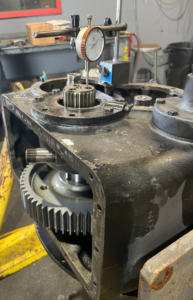
Technician uses a starrett dial indicator to measure the backlash between the gears on a Detroit Diesel engine.
Every 250–500 hours, check and confirm proper alignment between the engine and the MG-5091 transmission.
Why it matters:
- Thermal expansion, vibration, or hull flexing can cause alignment to drift.
- Misalignment leads to bearing overload, seal wear, and uneven clutch pressure.
- Even minor shifts can lead to soft foot conditions or shaft spline damage.
Alignment Check Steps:
- Use a dial indicator to measure face and rim runout between the transmission output flange and the shaft flange.
- Acceptable runout limits:
- Face: ≤ 0.002–0.004”
- Rim: ≤ 0.003”
- Use feeler gauges to check for soft foot by loosening one mount bolt at a time.
- Re-shim mounting pads if needed.
- Torque all mount bolts in a cross-pattern to final specification (typically 85–90 ft-lbs for 1/2” bolts).
Tip: Perform alignment checks after running the engine to normal operating temperature. Expansion can affect results.
2. Oil Sample Analysis
Analyzing the transmission oil at regular intervals gives valuable insight into component wear and oil health. Oil analysis is especially critical in commercial or high-hour service.
What to Look For:
- Iron/steel: Indicates gear or bearing wear
- Copper/brass: Clutch plate hub or bushing wear
- Water content: Breather failure or cooler leak
- Silicone: Contamination from poor storage or sealant breakdown
- Viscosity drop: Indicates oil breakdown from heat or wrong viscosity selection
Oil Sampling Procedure:
- Run the engine until the oil reaches 180°F.
- Draw a midstream sample from the oil drain or sampling port into a sterile, labeled container.
- Ship to a certified lab (such as Polaris Labs, Blackstone, etc.)
- Log results in a maintenance tracker.
Frequency:
- Light-duty: every 250 hours
- Heavy-duty or 24/7 operations: monthly or after each oil change
Abnormal wear particles often show up in oil long before symptoms appear in the gearbox.
3. External Cleaning and Fastener Check
Salt spray, engine room heat, and vibration contribute to corrosion and loosening of external components.
Monthly tasks should include:
- Cleaning the housing with degreaser and a soft brush
- Retorquing accessible fasteners (especially at the cooler lines and top covers)
- Inspecting gasket edges for signs of leakage
- Checking electrical or sensor connections for corrosion or frayed wires
4. Clutch Performance Evaluation

Over time, clutch plates inside the MG-5091 will wear due to engagement cycles.
Signs of clutch wear:
- Delayed or soft engagement
- Audible chatter or thunking during shift
- Gear slipping under high torque load
Test Procedure:
- Run the engine to operating temp.
- Engage forward and reverse under no load.
- Time the response (should engage within 0.5–1 second).
- Perform a “bump” test under load and monitor RPM drop — if slipping occurs, clutch inspection is recommended.
Long-Term Preventive Maintenance Tips
Record Keeping
Use a spreadsheet, app, or maintenance binder to log:
- Oil changes
- Filter replacements
- Alignment checks
- Leaks or abnormal noises
- Oil analysis results
- Parts replaced and service dates
Good records help with resale value, warranty claims, and scheduling major overhauls.
Spare Parts Inventory
Keep onboard or in the shop:
- Oil filters
- Mounting gaskets
- Output flange bolts
- SAE 30 or 40 oil
- Breather caps
- Magnetic plug
- Output seals (if operating remotely)
Technician Training
Ensure your maintenance team:
- Knows how to perform shaft alignment
- Can read and interpret oil pressure/temperature gauges
- Understands lockout/tagout procedures before maintenance
- Can identify worn clutch engagement symptoms
Summary
Routine Maintenance Schedule for Twin Disc MG-5091 Marine Gear
The Twin Disc MG-5091 is a robust, continuous-duty marine transmission — but even the best gearbox can fail without proper maintenance. The key to maximizing uptime, reducing repair costs, and ensuring smooth operation lies in executing this routine maintenance program consistently.
Maintenance at a Glance:
Daily:
- ✅ Check oil level
- ✅ Perform visual inspection
- ✅ Monitor startup pressure and temperature
Weekly:
- ✅ Inspect for leaks
- ✅ Torque output coupling bolts
- ✅ Clean breather and check external filter
Monthly/Quarterly:
- ✅ Re-check shaft alignment and torque mount bolts
- ✅ Perform oil sample analysis
- ✅ Clean gearbox housing and tighten top covers
- ✅ Evaluate clutch engagement response
Following this schedule ensures:
- Maximum clutch life
- Proper torque transfer
- Stable pressure and temperature
- Preventive detection of issues
It also builds a culture of accountability and safety aboard the vessel, which is especially important for commercial and fleet operations.

Rebuilt Twin Disc MG5091 Marine Transmissions
Plate Kit For Twin Disc MG5091 Marine Transmission
Gasket Kits For Twin Disc MG5091 Marine Transmission
Videos About Twin Disc Transmissions
6 Reasons Your Twin Disc Transmission Has Low Oil Pressure
7 Reasons Your Twin Disc Transmission Is Overheating
3 Reasons Your Clutch Plates in Your Twin Disc Transmission Are Making Excessive Noise
Bull Gear On A Twin Disc Transmission
Rebuilt Twin Disc Transmissions



 Free US Calls: 1-888-433-4735
Free US Calls: 1-888-433-4735 International: 305-545-5588
International: 305-545-5588